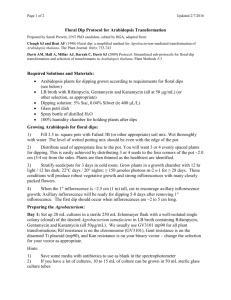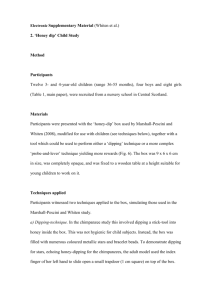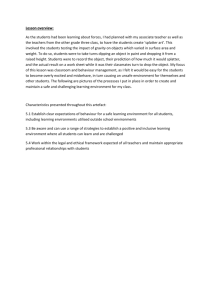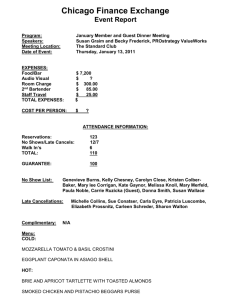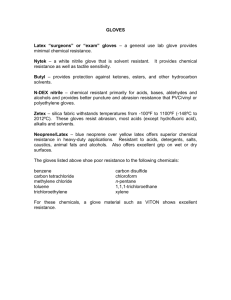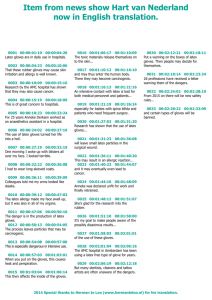Selection Guide for Dip Molding Machinery
advertisement
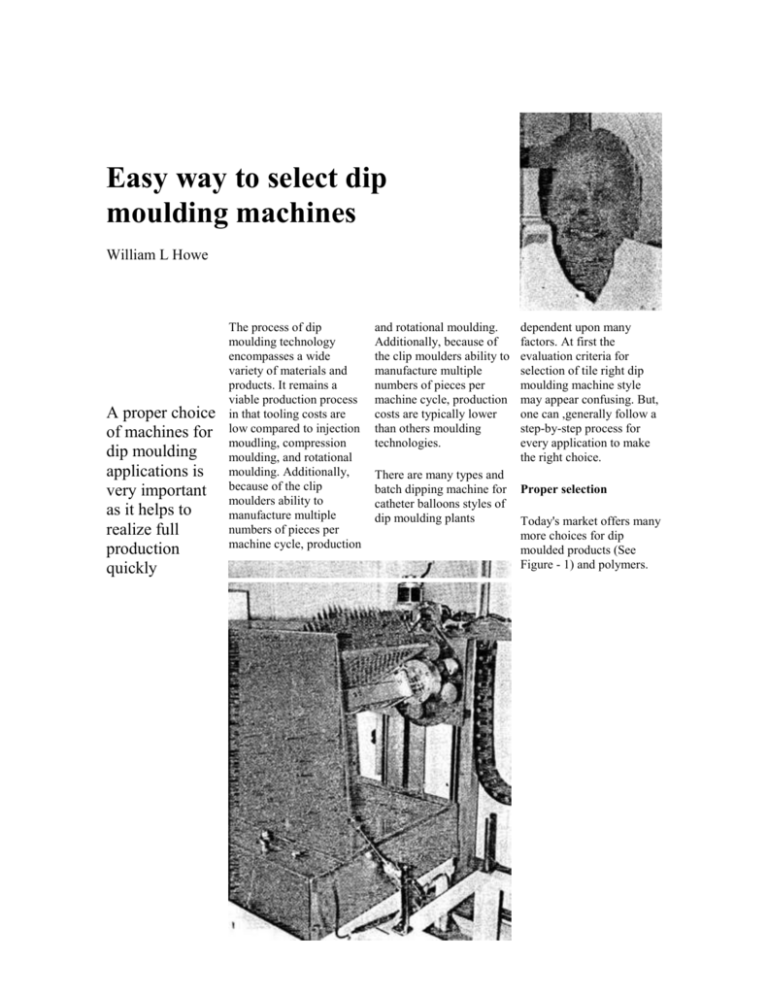
Easy way to select dip moulding machines William L Howe A proper choice of machines for dip moulding applications is very important as it helps to realize full production quickly The process of dip moulding technology encompasses a wide variety of materials and products. It remains a viable production process in that tooling costs are low compared to injection moudling, compression moulding, and rotational moulding. Additionally, because of the clip moulders ability to manufacture multiple numbers of pieces per machine cycle, production and rotational moulding. Additionally, because of the clip moulders ability to manufacture multiple numbers of pieces per machine cycle, production costs are typically lower than others moulding technologies. There are many types and batch dipping machine for catheter balloons styles of dip moulding plants dependent upon many factors. At first the evaluation criteria for selection of tile right dip moulding machine style may appear confusing. But, one can ,generally follow a step-by-step process for every application to make the right choice. Proper selection Today's market offers many more choices for dip moulded products (See Figure - 1) and polymers. Batch dipping machine for catheter balloons. When first evaluating an application for dip moulding there are many factors one should consider as part of the proper machine selection process, including the following; 1. Type of 2. 3. 4. 5. polymer(s) to be used. Type Of product or products (wall thickness, shape, design). Desired production output for the system. . Dedicated product versus multiple product system consideration. Maturity life cycle of the polymer/ product for dipping. Page 1 Types of machines Properly designed dip moulding plants are generally customized for the application, with a few exceptions. This does not necessarily mean that the dip Moulding manufacturer should customize all aspects of the machinery. For example, continuous chain glove and condom machines are offered by several machinery suppliers, and call generally be purchased as "standard" units. However, extreme into tile tank, or alternatively, the tank is raised to the pallet of formers. After completing the dip cycle, the pallet indexes to the next station, with a fresh pallet indexed to the same dipping station. Generally, the formers are affixed to the pallet in rigid fashion. However, oil rare occasions, formers can spin axially about the pallet axis. Vertical dipping using the batch indexing technique can occur through use Flow chart analysis assists decision making: As for most engineering and technical disciplines use of a basic flow chart with "yes-no" responses can generally lead the analyst to the proper selection of dip moulding technology. Using surprisingly short list of six questions, the writer estimates that approximately 98% of all accurately assessed using this simple flow chart (See Figure- 3) Extreme caution should be exercised if buying a "standard machine" Continuous chain latex glove dipping machine caution should be exercised if buying a "standard machine". For example, available oven space associated with the equipment may be insufficient for use with latex cold compounds as compared with prevulcanized latices. Some dip tank designs and on I one product leaching systems offered on standard lines may prove insufficient for some products. Tile two dipping formats for consideration ire as follows; of electrical motors, Selection factor #1 hydraulics, or compressed Product family: Most air (See Picture -1) . dipping plants worldwide generally are designed for production of a single 2. Continuous chain product. The application machines -Formers are Of continuous Chain Mounted oil Multiple technology for latex ,loves former racks, or individually and attached and latex condoms is commonplace. Tile prime to a continuous moving incentive for employing conveyer chain (roller continuous chain chain or transmission technology is that of chain). The line moves continuously at a constant economics and productivity. Glove dip speed, carrying formers through Clip tanks, ovens, lines today can produce from 1 million to 1.5 and associated process stations. Some continuous million gloves per day. chain machines feature re- Product market such as latex exam gloves, latex rotating forms, whereas condoms and latex novelty 1. Batch machines for others, the forms are balloons are extremely Formers (dipping moulds) fixed (See Picture- 2) competitive and must be are mounted oil pallets, often as 1.2 metres by 2.4 With the understanding of manufactured in high volumes to be profitable. metres. The pallets are these two basic machine moved intermittently, formats, tile evaluator normally on a consistent Multiple products Must then work through time cycle, to each tile following selection machine station. For factors so that proper Contrary to this scenario is actual dipping stations, machine selection can the firm who desires to the pallets move over tile occur. tank, and the pallet is dipped Page 2 produce multiple dipped products on a single system. A typical plant may produce specialty dlipped goods using a "private label" strategy, offering their services for lower volume, but higher profit margin items. Examples of products typically produced ill this type of plant would be probe covers, cast covers, specialty gloves, boots and bellows. One dipping plant in Europe today not only produces over 50 types Of products Oil one dipping machine, but also processes them simultaneously. At any given time during tile production day, between 3 to 8 different Clipped products are being produced oil the dip cell. The advantages reduced dipping mandrel In general, batch dipping technology is employed for multiple product families within the same plant. Contrary to this, is, high volume dedicated products are most economically produced on Continuous chain lines, providing they meet the other selection criteria to follow. Selection factor # 2 pilot dipping plants lab scale units: It is possible that no other technology in tile rubber and plastic industry, varies more widely than that of dip moulding Machines come in all shapes and sizes and can vary ill price significantly, dependent upon the business objective of the project. Small-scale lab dipping unit As mentioned in previous text, continuous chain Figure - 1 Medical gloves Unsupported work gloves Supported work gloves Condoms Urinary foley catheters Male external catheters Rebreathing bags Medical bellows Tool handle grips Industrial caps and plugs Nose cannula Windshield wiper boots Foam drink can insulators inventory, reduced work ill process, and reduced finished goods inventory. Additionally, shelf life is seldom in issue with this plant. Swim caps Cast covers Prosthesis covers Toy balloons Angioplasty balloons Artificial heart casing Breast implant casings Latex toys Drinking cup caps Coated automotive rods/brackets Plated electrical parts Medical airways Penile implants Coated glass Shoe covers/boots Baby teats/pacifiers Baby feeding nipples Engine head gaskets Coated parts Face masks Medical bags Blood pressure cuffs Medical connectors technology has significant benefits in reducing production costs. Many firms today prepare themselves for the ever chang ing market for alternative polymers through the use of a computerized controlled Laboratory Dipping Unit (See Picture 3). These machines are invaluable for verifying and improving dipping and temperature profiles oil a practical scale, Probe covers Medical tubing Medical cushions Page 3 prior to introducing modifications to the production equipment. Even for the plant which manufactures products only by Continuous Chain processing, laboratory scale dipping units are normally designed as batch dipping units to optimize flexibility. The ability to alter dipping profiles, Cure oven specifications, and environmental issues, greatly favours tile use of batch dipping. Research scale machines should be designed in this format. Machine ratings for polymer usage Key: N = Never used, S Seldom used, M = Moderate use, F Frequent use, Type of polymer Natural rubber latex Polyvinyl chloride (PVC) Nitrile Polyurethane Neoprene Silicone Heat sensitive latex Styrene butadiene Polycarbonite Cellulose A = always Industry% Continuous 63% 15% 7.5% 6% 3.5% 2.8% 1.5% 0.5% 0.1% 0.1% Figure 2 Selection factor # 3 product film thickness: One key quality for nearly all dipped products is that of consistent wall thickness and uniformity. Simply Put, the larger tile will thickness, the more one would tend to employ batch dipping technology. Generally, any product With wall thickness in excess of 15-mil should fall into this category. Examples of products generally clipped oil batch dipping machines because of thicker wall dimensions include electricians' gloves, baby teats and pacifiers, baby feeding nipples, foley catheters, and rebreather bags. greatly in length, requiring a larger capital investment. Furthermore, dip tank management becomes more difficult to maintain consistency across 4 or more dip tanks. Some latex gloves, latex condoms and unsupported nitrile gloves are Manufactured employing 3 dips on a continuous chain system. Selection factor #4 dipping mandrel shape: The dipping process can utilize many different mandrel shapes and materials. Material selection alone can be a thought provoking question, tile subject of which warrants publishing of future Products such as thin film detailed information nitrile gloves, medical under separate cover. latex gloves, condoms and novelty balloons In general, symmetrical perform well on mandrel shapes dip well continuous Chain machines, in part because using continuous chain machines. Dipping machines, because of its odd shape. The very recognizable "Mickey Mouse" balloon by Disney, is best dipped using batch machine technology, to ensure optimum cosmetic appearance. Selection factor # 5 process maturity: One disadvantage of continuous chain machines, is its inherent inflexibility. Product performance becomes dependent entirely upon line speed. If the manufacturer discovers methods by which the line speed can be increased because of advancement in the dipping tank, tile manufacturer must also ensure that all other operations oil the dipping line, call also withstand the speed increase. A 10% speed increase in the chain speed may not be Chain F F M S S N N S N N Batch indexing F F F F F A A F A A of the ability to maintain consistent wall thickness with lower viscosity dipping materials. Some dipping companies may wish to explore the ability to make a product With 15 mil or greater wall thickness, on a continuous Chain machine. This call be practical providing that the multiple dips to achieve this total not more than 3. If employing more than 3 clip tanks to achieve this wall thickness, the conveyer begins to extend mandrel examples of this type include glass condom formers glove formers, and standard bulb shaped balloon mandrels. However, the more intricate and nonsymmetrical tile former, the more difficult it becomes to dip with oil continuous chain machines. Many novelty balloons are designed to replicate old shapes for marketing purposes. For example, "bird shaped balloons" are typically clipped oil batch tolerated because of reduced oven exposure time. The Manufacturer Must adjust temperatures and/or air flow (if the machine has a convection oven design) to enable the finished product to maintain acceptable physical characteristics. Alternatively, additional off line curing via tumbler/dryer may prove feasible for this condition. New product design often requires between 2 to 5 years of maturity in process definition, Page 4 chemistry, etc. before stabilizing the process. Installing a continuous chain machine, too early in the product life cycle, can make manufacturing scale up difficult and expensive. The manufacturer may become mired in making changes to the chain machine, which takes time and labour. Dipping profile changes for some continuous chain machines are nearly impossible to alter. Chain machines that have dipping cams which can be altered are only do so by the "heat and beat" method. More simply put, cams must be torch cut and-welded into place which can idle a machine for 24 hours. Alternatively, batch machine dipping profiles can be modified through the use of proximity switches and speed dials, which can be adjusted in Page 5 O ne disadvantage of continuous chain machines is its inherent inflexibility 15 minutes to 30 minutes time. PLC control technology, made commonplace 10 years ago by ACC Automation Co., can enable I manufacturer to alter clipping and oven profiles in a matter of minutes. In projects where process definition is vague 'and undefined, the use of batch dipping machines is advised. Based upon tile writer's experience, the industry breakdown for material usage is also shown ill parenthesis next to tile polymer identification, ill Figure - 2. As call be seen, natural rubber latex still is the dominant material used ill tile industry today, for reasons of comfortable fit at a competitive price. Water based materials (Such as natural rubber latex, nitrile, and neoprene) are normally adaptable Selection factor # 6 - type of polymer: Today's market offers far to both types of machines, more polymer alternatives than 30 dependent upon film this thickness and component shape. Solvent years ago, when latex was nearly tile only material available for clip based polymers (such as polyurethane, silicone, styrene Moulding. Protein issues associated with natural rubber latex butadiene, and polycarbonate) ,ire seldom clipped oil Continuous have opened up Opportunities for Chain machines. new polymers, especially for medical clipped goods that are invasive to the body. Many There are exceptions to this catheter products and medical statement, in that a few solvent balloons today are constructed of based gloves and condoms are either silicone or polyurethane for manufactured oil Continuous chain this reason. machines. However, manufacturing start LIP for these solvent based Page 6 start LIP for these solvent based continuous chain plants call be extremely difficult and lengthy. Moving formers Continuously in two axes (horizontal and vertical) simultaneously, as occurring ill continuous chain dip lines, can disturb the polymer in tile dip tank, causing solvent gassing (bubbles in solution), leading the pinholes and weak spots in the film. Most dipping projects require significant investment capital for equipment. Making tile proper choice in machinery style will enable the manufacturer to more quickly realize full Production levels, reduce start Lip frustrations, and more importantly, reduce investment and working capital costs.
